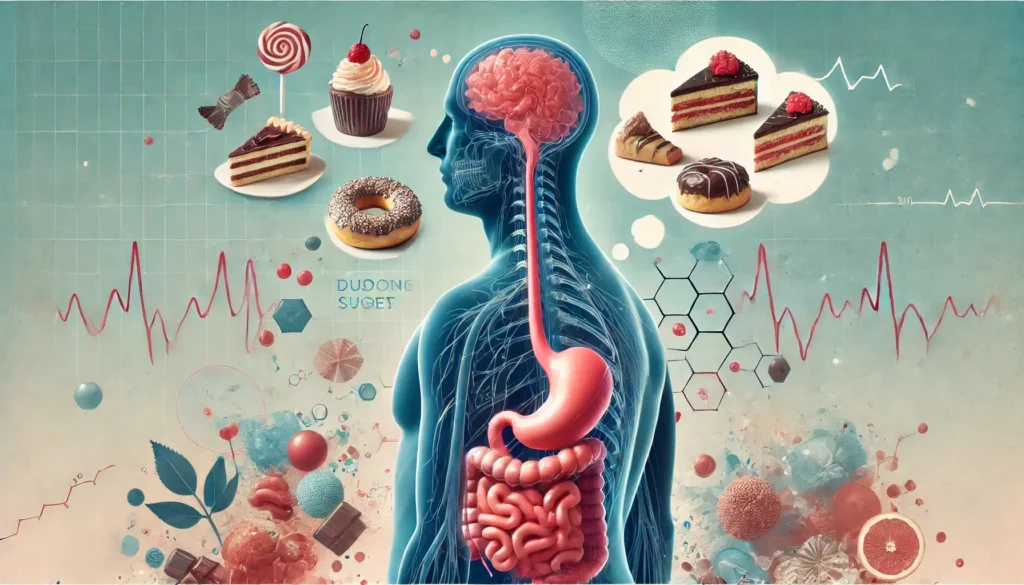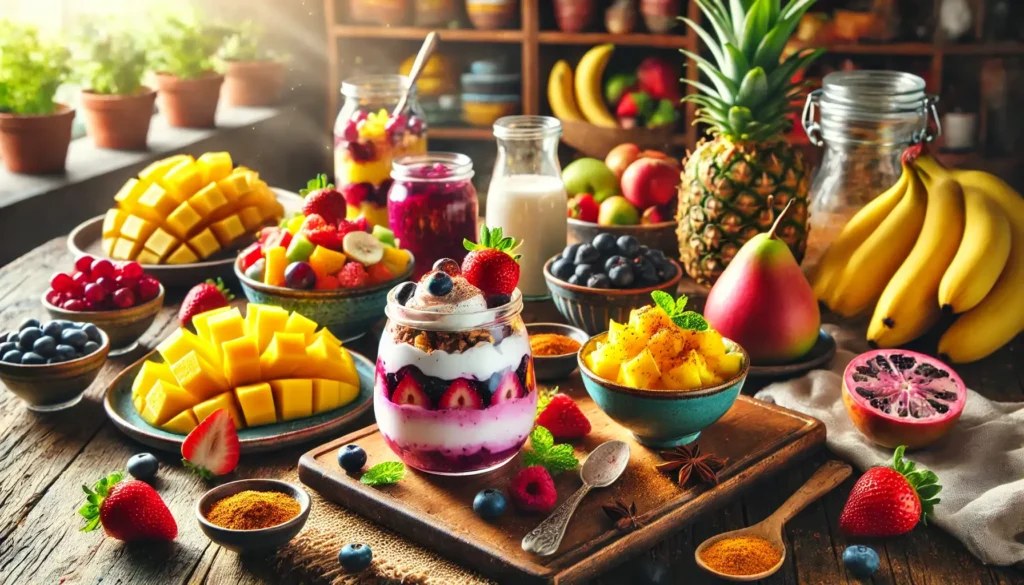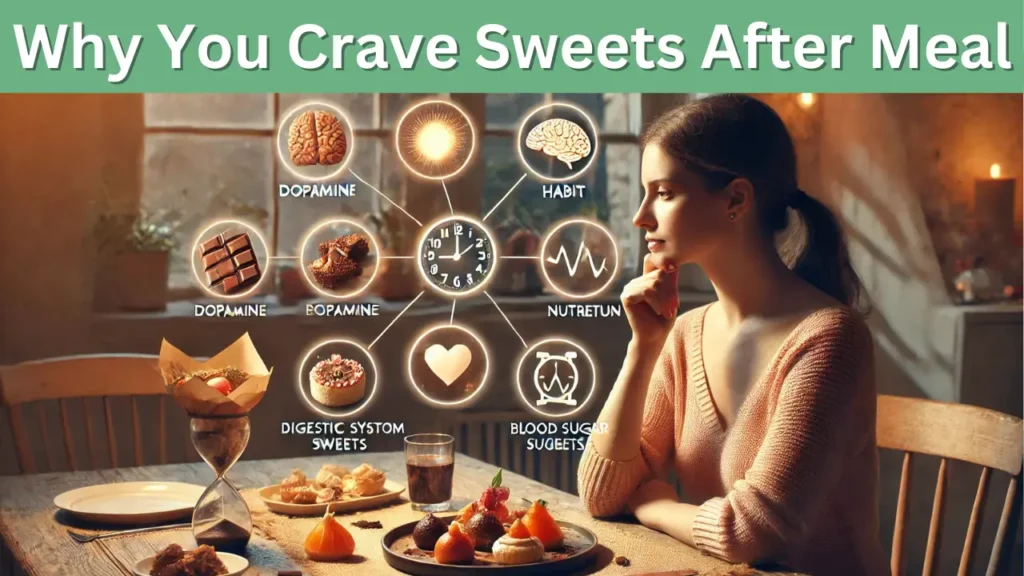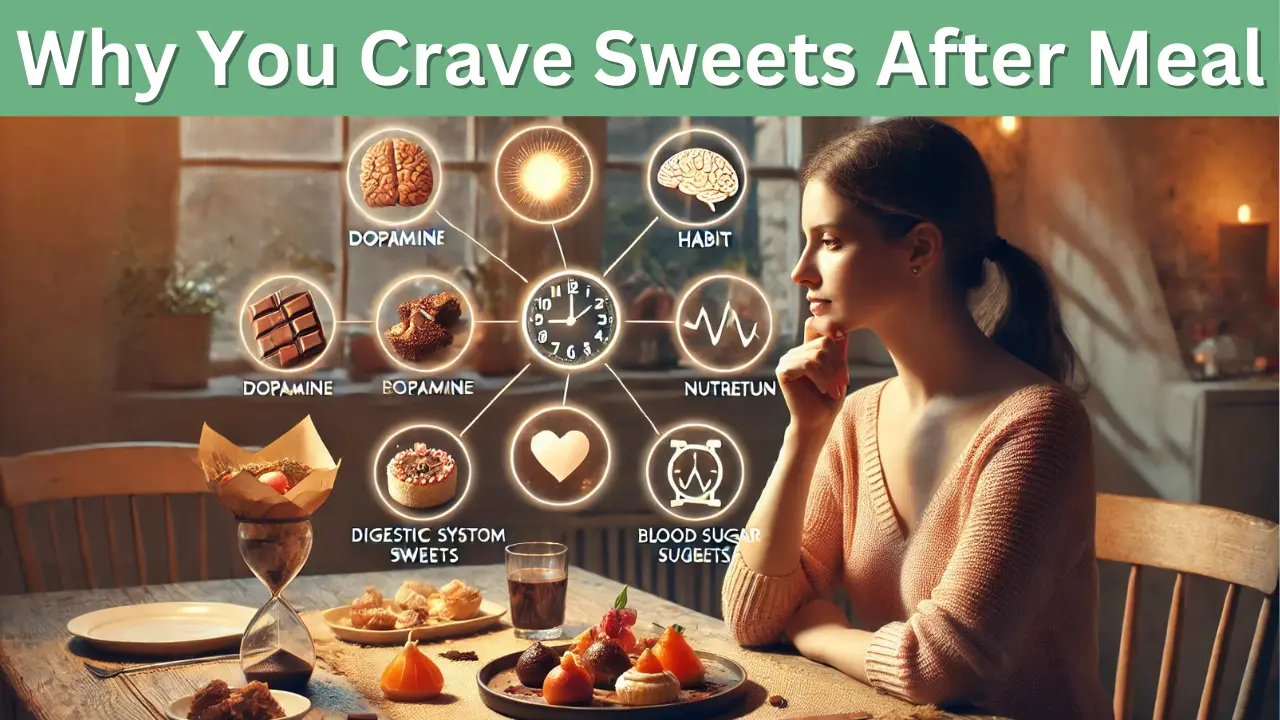Craving something sweet after finishing a meal is a very familiar experience for many people. Whether it’s the desire to indulge in a piece of gulab jamun, a square of chocolate, or a spoonful of kheer, the temptation to enjoy a dessert can often feel difficult to resist. But have you ever wondered why this happens? There are several underlying reasons why you crave sweets after meal, and understanding these can be helpful in managing your cravings and making healthier decisions. In this article, we will delve into six key reasons behind this post-meal craving and suggest practical tips to help you reduce or control these urges.
1. The Need for a Dopamine Boost

After a satisfying meal, it is quite natural for your brain to look for a reward that enhances feelings of pleasure and satisfaction. This is where dopamine, often known as the “feel-good” neurotransmitter, plays an important role. Dopamine is linked to feelings of pleasure, reward, and motivation. When you eat something sweet, dopamine levels rise, giving you a sense of comfort, relaxation, and happiness.
Why Does This Happen?
Biological Response:
When you finish a meal, your brain expects a signal that marks the completion of the eating process. Sweets provide an easy and dependable way to meet this expectation because they quickly trigger the release of dopamine. This natural response makes you feel like the meal has come to a satisfying conclusion.
Conditioned Behavior:
If you regularly eat sweets after your meals, your brain starts associating the end of a meal with the enjoyment of a sweet treat. Over time, this forms a habit that can be hard to break. The more you follow this pattern, the stronger the conditioned response becomes, making your craving for sweets feel automatic and irresistible.
Example Scenario
Picture yourself enjoying a full and satisfying meal of dal, rice, and sabzi. Even though you feel quite full, your brain might still prompt you to reach for a small serving of gajar halwa to feel completely satisfied. The sweet treat acts as a reward, signalling the end of the meal and reinforcing a sense of completeness and pleasure.
How to Manage This Craving
- Mindful Eating:
After your meal, take a pause for a few minutes and reflect on whether you are genuinely hungry or simply looking for that sense of reward. This moment of awareness can help you make better choices. - Healthier Alternatives:
Instead of traditional sweets, try reaching for healthier options such as fresh fruits, dates, or a small piece of dark chocolate. These alternatives can provide sweetness while being more nutritious. - Gradual Reduction:
If the habit is deeply ingrained, try slowly reducing the portion size of your dessert. For instance, if you usually have a full piece of barfi, consider having just half. Gradually decreasing the amount can help break the conditioned craving over time.
By understanding the reasons why you crave sweets after meal and making mindful adjustments, you can better manage these cravings while maintaining healthier habits.
2. Habitual Eating Patterns

In Indian culture, ending a meal with a sweet dish is more than just a preference — it is a deeply rooted tradition. From mishti doi in Bengal to payasam in Kerala, sweets have long been an essential part of the dining experience. This customary way of concluding a meal often creates a habitual eating pattern, making it feel incomplete without a sugary treat at the end.
Why Does This Happen?
Cultural Influence:
Indian traditions place significant importance on sweets. They are used not just for satisfying a craving but also for celebrating happy occasions, expressing hospitality, and marking the completion of a meal. This cultural emphasis reinforces the association between finishing a meal and having something sweet.
Routine Reinforcement:
If you grew up in a household where meals typically ended with a dessert, this pattern has likely become second nature. Your brain has adapted to expect a sweet conclusion, and the absence of it can make the meal feel unfinished. Over time, this repeated practice strengthens the craving for sweets after meals.
Example Scenario
Think of a typical family gathering where a lavish meal of pulao, paneer curry, and raita is served. No matter how full you feel, the meal often ends with desserts like rasgulla, laddu, or jalebi. This pattern, repeated over the years, becomes more than just a tradition — it becomes an ingrained habit. Even when you eat alone or have a simple dinner, you may still feel the need to complete the experience with something sweet.
How to Manage This Craving
- Break the Routine Gradually:
Start by substituting traditional sweets with healthier options such as fresh fruits, a bowl of plain yogurt with honey, or treats made with jaggery. These alternatives can offer a hint of sweetness while being more nutritious. - Mindfulness Techniques:
When you feel the urge for sweets, take a moment to assess whether this craving is due to habit or actual hunger. Try to distract yourself by going for a short walk, sipping on a glass of water, or engaging in a quick activity to break the automatic response. - Plan Ahead:
If you know that the craving for sweets is inevitable, prepare healthier choices in advance. Keeping fruits, dates, or a small portion of chikki (jaggery and peanut brittle) on hand can help you satisfy the craving without indulging in heavy desserts.
By understanding the reasons why you crave sweets after meal and making small, conscious changes to your routine, you can gradually manage these cravings while maintaining a balance between tradition and health.
3. Digestive Responses

The body’s digestive processes are another significant factor behind the reasons why you crave sweets after meal. When you eat a meal rich in carbohydrates, proteins, and fats, your digestive system works hard to break down these nutrients and convert them into energy. During this process, there can be fluctuations in blood sugar levels, which can sometimes trigger the urge to consume something sweet to quickly restore energy.
Why Does This Happen?
Blood Glucose Dip:
After you eat a meal, particularly one high in carbohydrates like rice, roti, or idli, your blood sugar levels initially spike. In response, the body releases insulin to manage this spike. However, this regulation process can sometimes cause a sudden drop in blood sugar levels, which creates a feeling of low energy or tiredness. This dip in blood glucose signals your body to seek a quick source of energy, and sweets are a fast and convenient way to satisfy this need.
Quick Energy Source:
Sugary foods offer an immediate boost of glucose, which is why they seem so appealing after a meal. This quick surge of energy helps counteract the drop in blood sugar, making you feel more energised and satisfied.
Example Scenario
Imagine you’ve just finished a meal of roti, sabzi, and chana. Initially, your blood sugar level rises due to the carbohydrates in the meal. But once insulin starts working to bring it down, you may experience a sudden dip in energy. This can create an urge to reach for something sweet, like a piece of jalebi or barfi, to quickly balance out your energy levels and feel better.
How to Manage This Craving
- Balanced Meals:
To prevent sharp spikes and dips in blood sugar, ensure your meals include a good mix of proteins, healthy fats, and fiber. For example, add foods like paneer, lentils, nuts, and leafy greens to your meals. This balance helps in maintaining steady energy levels and reduces the likelihood of cravings. - Stay Hydrated:
Sometimes, your body may confuse thirst with a craving for sweets. Before reaching for a dessert, try drinking a glass of water and wait for a few minutes to see if the craving subsides. - Post-Meal Walk:
Taking a short walk after your meal — even 10 to 15 minutes — can help regulate blood sugar levels by aiding digestion and improving insulin sensitivity. This practice can reduce the sudden urge for sweets and promote overall well-being.
By understanding how your digestive system influences the reasons why you crave sweets after meal, and making simple adjustments to your diet and routine, you can better manage these cravings and maintain a healthier lifestyle.
4. Nutrient Deficiencies

Sometimes, the reasons why you crave sweets after meal go beyond mere habit or the desire for a pleasurable treat. These cravings can also indicate a deficiency in essential nutrients that your body needs to function efficiently. Your body requires a balanced intake of vitamins and minerals to support energy production and overall well-being. When you are deficient in certain nutrients, particularly those involved in energy metabolism, your body may mistakenly signal a need for sugar to make up for these shortfalls.
Why Does This Happen?
Magnesium Deficiency:
Magnesium is crucial for regulating blood glucose levels and supporting insulin function. If your body is low in magnesium, it may struggle to maintain stable blood sugar levels, leading to poor glucose management. This can trigger cravings for chocolate or other sugary foods, as your body seeks a quick source of energy to compensate.
Zinc and Chromium Deficiencies:
Zinc and chromium are essential minerals that help your body process and use glucose efficiently. These minerals play a key role in insulin function and overall glucose metabolism. When you are deficient in zinc or chromium, your body may find it difficult to manage blood sugar effectively. This inefficiency can cause sudden sugar cravings as a way to quickly boost energy levels.
General Nutrient Imbalance:
A diet heavy in processed and refined foods often lacks essential vitamins and minerals. When your body doesn’t receive the nutrients it needs, it compensates by craving sugar-rich foods, which offer a quick but temporary energy boost. Over time, this pattern can further deplete your nutrient stores and reinforce unhealthy cravings.
How to Manage This Craving
- Eat a Nutrient-Dense Diet:
To address nutrient deficiencies, include foods rich in magnesium, zinc, and chromium in your daily meals. Some nutrient-dense options are:- Magnesium: Almonds, pumpkin seeds, spinach, bananas, and methi seeds.
- Zinc: Lentils, chickpeas, dairy products, cashews, and rajma.
- Chromium: Whole grains, broccoli, green beans, and tomatoes.
- Consider Supplements:
If you suspect that you have nutrient deficiencies, consult a healthcare professional or a dietician. They can conduct necessary tests and recommend appropriate supplements to help meet your specific needs. - Diversify Your Plate:
Ensure that your meals are well-balanced and colorful. Incorporate a variety of vegetables, whole grains like millets, lean proteins such as fish, chicken, and pulses, and healthy fats like those found in nuts, seeds, and avocados. This approach ensures your body gets a wide range of nutrients to function properly.
By understanding the reasons why you crave sweets after meal related to nutrient deficiencies and making adjustments to your diet, you can effectively manage these cravings. Prioritizing a nutrient-rich diet will not only reduce the desire for sweets but also enhance your overall health and energy levels.
5. Blood Sugar Imbalances

One of the primary reasons why you crave sweets after meal is due to blood sugar imbalances. When you consume meals high in refined carbohydrates or sugars, your blood glucose levels experience a rapid spike. This sudden increase is often followed by a sharp drop, leaving you feeling tired, sluggish, and craving sweets to quickly replenish your energy.
Why Does This Happen?
Insulin Spike and Crash:
Refined carbohydrates, such as white rice, white bread, and sugary items like pastries and sweets, cause a rapid rise in blood sugar levels. In response, your body releases a large amount of insulin to manage this spike and bring your blood sugar down. Unfortunately, this process can sometimes lead to a dramatic drop in glucose levels (known as hypoglycemia). This sudden crash can leave you feeling drained and signals your body to look for an immediate source of energy, which often comes in the form of sweets.
Energy Crash:
When your blood sugar levels plummet after the initial spike, it results in a feeling of fatigue and low energy. This energy crash prompts your body to crave something sweet, as sugary foods offer a quick, temporary fix to raise blood glucose levels and restore energy.
How to Manage This Craving
- Eat Balanced Meals:
To maintain stable blood sugar levels, ensure your meals contain a healthy balance of proteins, healthy fats, and fiber. For example:- Protein: Include options like chicken, fish, eggs, tofu, paneer, or legumes.
- Healthy Fats: Incorporate foods like avocado, nuts, seeds, and oils such as olive oil or mustard oil.
- Fiber: Add plenty of vegetables, whole grains like brown rice or millet, and fruits to your plate.
- Avoid Refined Sugars:
Try to cut down on foods high in refined sugars, such as sugary drinks, sweets, and bakery items made with white flour. Instead, opt for complex carbohydrates like brown rice, whole wheat, oats, or quinoa, which digest more slowly and help keep blood sugar levels steady. - Smaller, Frequent Meals:
Instead of eating large meals, consider having smaller, more frequent meals throughout the day. This practice helps maintain consistent energy levels and prevents sudden dips in blood sugar. - Stay Hydrated:
Sometimes, the body confuses thirst with sugar cravings. Drink water regularly throughout the day and have a glass of water after meals to help curb unnecessary cravings.
By recognising how blood sugar imbalances contribute to the reasons why you crave sweets after meal, and making small adjustments to your diet and eating habits, you can keep your energy levels stable and reduce the urge for sweets. These changes will not only help you manage cravings but also improve your overall health and well-being.
6. Cultural and Emotional Connections

In India, the connection with sweets goes far beyond taste; it is deeply embedded in our culture and emotions. From grand festive celebrations to intimate family gatherings, desserts like halwa, barfi, laddu, and jalebi have always played an essential role in marking moments of joy, prosperity, and togetherness. These cultural practices and emotional ties are among the key reasons why you crave sweets after meal.
Why Does This Happen?
Tradition and Ritual:
In Indian households, serving a sweet dish at the end of a meal is often considered a symbol of hospitality, celebration, and abundance. Whether it’s offering mishti doi to guests or ending a thaali meal with a small piece of barfi, this practice has been passed down through generations. This traditional ritual makes the act of craving sweets after a meal feel both natural and expected. Over time, it becomes a subconscious part of the dining experience.
Emotional Eating:
Sweets often hold sentimental value, reminding us of childhood, family gatherings, and festive seasons. The aroma of freshly prepared gajar halwa or the sight of golden jalebis can evoke feelings of nostalgia and comfort. This emotional connection can lead to cravings even when you are not physically hungry, making it hard to resist reaching for a sweet treat after a meal.
How to Manage This Craving
- Healthier Traditional Options:
Opt for traditional alternatives that are healthier yet satisfy your sweet tooth. Instead of sugar-laden desserts, choose options like:- Gur (jaggery): Offers natural sweetness and essential minerals.
- Dates: A nutrient-rich sweet option packed with fiber.
- Dry Fruits: Almonds, cashews, and raisins provide a satisfying crunch along with natural sweetness.
- Mindful Eating:
Before giving in to the craving, take a moment to reflect on whether you truly need something sweet or if it’s just an emotional response. Pause, breathe, and ask yourself if you are genuinely hungry or simply following a habitual pattern. - Limit Dessert Frequency:
Enjoy traditional sweets during festivals, weddings, and special occasions, but try to avoid making them a part of your daily routine. Saving sweets for special moments can make them feel more meaningful and help you maintain a healthier lifestyle. - Create New Rituals:
Replace the habit of eating sweets with healthier post-meal practices. For instance:- Enjoy a cup of herbal tea like peppermint or fennel to aid digestion.
- Have a small bowl of fresh fruit such as papaya or an apple for natural sweetness.
- Try a spoonful of saunf (fennel seeds), which is a traditional mouth freshener and aids digestion.
By understanding the cultural and emotional reasons why you crave sweets after meal and making thoughtful changes, you can strike a balance between honouring traditions and maintaining a healthier lifestyle.
Also Read: Ways to Have a Flat Stomach in 10 Days: The Ultimate Hack for a Toned Tummy!
Tips to Curb Sweet Cravings After Meals
It is entirely possible to manage the reasons why you crave sweets after meal with some thoughtful strategies and small changes to your lifestyle. By following these effective tips, you can reduce your post-meal sweet cravings and cultivate healthier habits.

1. Include Protein in Your Meals
Adding a good source of protein to your meals can help maintain stable blood sugar levels and keep you feeling full for longer. This reduces the chances of sudden energy crashes that lead to sweet cravings.
- Examples: Eggs, legumes (chana, rajma), chicken, fish, paneer, or tofu. Including a dal or a portion of grilled chicken with your meal can be an excellent choice.
2. Stay Hydrated
Sometimes, your body may confuse thirst with a craving for sugar. Drinking enough water before and after your meals can help reduce these false cravings.
- Tip: Keep a glass of water handy while eating and sip it throughout the meal to support digestion and reduce the urge for sweets.
3. Eat Fruits Instead of Desserts
If you feel the need for something sweet after a meal, opt for fresh fruits. Fruits provide natural sugars along with fiber, vitamins, and antioxidants, making them a healthier alternative to traditional sweets.
- Examples: Apples, oranges, bananas, papaya, or a bowl of mixed berries.
4. Plan Balanced Meals
Make sure your meals include a balance of healthy fats, fiber, protein, and complex carbohydrates. This combination helps prevent blood sugar spikes and crashes, reducing the likelihood of craving sweets.
- Balanced Meal Ideas:
- Whole wheat roti with paneer and a side of sabzi.
- Brown rice with dal, vegetables, and a small portion of yogurt.
- Millet-based dishes with a serving of lean meat or legumes.
5. Practice Mindful Eating
After finishing your meal, take a moment to pause and assess whether you are genuinely hungry or if your craving for sweets is just a habit. Mindful eating helps you make conscious choices rather than following automatic patterns.
- Tip: Engage in a short walk or a relaxing activity like deep breathing or listening to music to distract yourself from the craving.
6. Exercise Regularly
Regular physical activity helps regulate your blood sugar levels, boost your mood, and reduce cravings for sweets. Exercise stimulates the production of endorphins, which can give you a sense of well-being without the need for sugar.
- Activities to Try: Brisk walking, yoga, cycling, or even simple home workouts.
7. Get Enough Sleep
Lack of sleep can disrupt the hormones responsible for hunger and satiety, leading to increased cravings for sugar and junk food. Ensure you get 7-8 hours of restful sleep every night to keep your hunger signals balanced.
- Tip: Maintain a consistent sleep schedule and create a relaxing bedtime routine.
By applying these practical tips and understanding the reasons why you crave sweets after meal, you can gradually reduce your dependency on sugary treats and adopt healthier habits. Over time, these small changes will make a big difference in your overall health and well-being.
Healthy Dessert Ideas you can try !
1. Fruit-Based Desserts

- Grilled Pineapple Slices
- How to Make: Grill fresh pineapple slices and sprinkle with cinnamon.
- Benefits: Contains natural sugars, fiber, and antioxidants.
- Berry Yogurt Parfait
- How to Make: Layer Greek yogurt with fresh berries (strawberries, blueberries, raspberries) and a drizzle of honey.
- Benefits: High in protein, antioxidants, and probiotics.
- Mango with a Dash of Chaat Masala
- How to Make: Freshly cut ripe mango sprinkled with chaat masala or black salt.
- Benefits: Naturally sweet with fiber and vitamins.
- Banana Ice Cream
- How to Make: Freeze ripe bananas, then blend until creamy. Add a dash of vanilla or cocoa powder for flavor.
- Benefits: Dairy-free, potassium-rich, and no added sugar.
2. Nut and Seed-Based Desserts
- Date and Nut Energy Balls
- How to Make: Blend dates, almonds, cashews, and a touch of coconut oil. Roll into bite-sized balls.
- Benefits: Natural sweetness, fiber, and healthy fats.
- Chia Seed Pudding
- How to Make: Mix 3 tablespoons of chia seeds with 1 cup of milk (or plant-based milk). Let it sit overnight and top with fruits.
- Benefits: High in omega-3, fiber, and protein.
- Roasted Almonds with Dark Chocolate Drizzle
- How to Make: Lightly roast almonds and drizzle with melted dark chocolate (70% cocoa or higher).
- Benefits: Antioxidants, protein, and healthy fats.
3. Traditional Indian Sweets with a Healthy Twist
- Jaggery-Sweetened Kheer
- How to Make: Replace sugar with jaggery in traditional rice kheer. Add nuts for crunch.
- Benefits: Jaggery is rich in minerals like iron and is less processed than refined sugar.
- Ragi Halwa
- How to Make: Use ragi (finger millet) flour, ghee, milk, and jaggery to make a nutritious halwa.
- Benefits: High in calcium, iron, and fiber.
- Dates and Nuts Barfi
- How to Make: Blend dates with crushed nuts, press into a tray, and cut into squares.
- Benefits: No added sugar, high in fiber, and nutrient-dense.
- Baked Gulab Jamun
- How to Make: Bake the dough balls instead of deep frying and use a lighter sugar syrup with less sugar or honey.
- Benefits: Lower in fat and sugar compared to the traditional version.
4. Chocolate-Based Desserts

- Dark Chocolate-Covered Strawberries
- How to Make: Dip fresh strawberries in melted dark chocolate (70% or higher) and chill until set.
- Benefits: Antioxidants, vitamins, and minerals.
- Avocado Chocolate Mousse
- How to Make: Blend ripe avocados with cocoa powder, honey, and a splash of vanilla. Chill before serving.
- Benefits: Healthy fats and antioxidants.
- Cocoa-Nut Bliss Balls
- How to Make: Mix shredded coconut, cocoa powder, and a small amount of honey. Roll into balls.
- Benefits: Provides healthy fats and fiber with minimal sugar.
5. Frozen Treats
- Frozen Yogurt Bark
- How to Make: Spread Greek yogurt on a tray, sprinkle with fruits, nuts, and a drizzle of honey. Freeze until firm and break into pieces.
- Benefits: Protein-rich and customizable.
- Fruit Popsicles
- How to Make: Blend fruits like mango, watermelon, or kiwi with a splash of coconut water. Pour into molds and freeze.
- Benefits: Hydrating and free from added sugars.
- Frozen Grapes or Bananas
- How to Make: Simply freeze grapes or banana slices for a cold, sweet snack.
- Benefits: Naturally sweet, refreshing, and low-calorie.
6. Baked Desserts

- Oatmeal Cookies
- How to Make: Use oats, mashed bananas, and a handful of raisins or dark chocolate chips. Bake until golden.
- Benefits: Whole grains, fiber, and no refined sugar.
- Baked Apples with Cinnamon
- How to Make: Core an apple, fill with chopped nuts and a sprinkle of cinnamon, and bake until tender.
- Benefits: Vitamins, fiber, and a naturally sweet taste.
- Carrot Muffins (No Added Sugar)
- How to Make: Use whole wheat flour, grated carrots, and sweeten with dates or applesauce.
- Benefits: Provides fiber, beta-carotene, and natural sweetness.
Tips for Healthier Desserts
If you are looking to satisfy your sweet tooth while staying mindful of your health, it is possible to enjoy desserts in a way that benefits your overall well-being. Here are some practical tips to create healthier dessert options and better manage the reasons why you crave sweets after meal.
1. Use Natural Sweeteners
Instead of refined white sugar, consider using natural sweeteners that offer additional nutrients and a richer flavour. These options are less processed and can provide some health benefits.
- Examples:
- Honey: A natural antibacterial and antioxidant-rich option.
- Jaggery (gur): Rich in iron and minerals, it provides a wholesome sweetness.
- Dates: Naturally sweet and high in fiber, they are ideal for binding desserts.
- Maple Syrup: A good source of antioxidants and minerals like zinc.
Tip: Use jaggery or honey in traditional desserts like kheer or halwa for a healthier twist.
2. Add Protein and Fiber
To make desserts more filling and satisfying, include sources of protein and fiber. This can help manage blood sugar levels and reduce the urge to overeat sweets.
- Protein Options:
- Nuts: Almonds, walnuts, and cashews add crunch and healthy fats.
- Seeds: Chia seeds, flaxseeds, or pumpkin seeds boost nutrition.
- Greek Yogurt: A protein-rich alternative to cream or condensed milk.
Idea: Try making a fruit and nut parfait with layers of Greek yogurt, chopped fruits, and a sprinkle of nuts and seeds.
3. Portion Control
Enjoying desserts doesn’t mean you have to give them up entirely. Practising portion control allows you to satisfy your cravings without overindulging.
- Tips for Portion Control:
- Serve sweets in smaller bowls or plates to create the impression of a fuller portion.
- Limit yourself to a single piece of barfi or laddu rather than multiple servings.
- Savour each bite slowly to extend the enjoyment and feel satisfied with less.
Example: Instead of a full bowl of gajar halwa, try a small spoonful paired with a handful of nuts.
4. Focus on Whole Foods
Incorporate whole foods like fruits, grains, and nuts into your desserts to increase their nutrient content. Whole foods offer vitamins, minerals, fiber, and healthy fats that refined desserts lack.
- Ideas for Whole Food Desserts:
- Fruit-Based Desserts: Try baked apples with cinnamon, or a bowl of fruit chaat with a sprinkle of chaat masala.
- Whole Grain Treats: Replace refined flour with whole wheat or oats for desserts like atta laddus or oatmeal cookies.
- Nutty Sweets: Use blended nuts and dates to make energy bites or homemade chikki (peanut and jaggery brittle).
Tip: A banana smoothie with almonds and a drizzle of honey is a quick, nutritious, and satisfying dessert.
By adopting these tips, you can enjoy healthier desserts that nourish your body while addressing the reasons why you crave sweets after meal. Making these small adjustments can help you maintain balance, indulge in moderation, and feel good about your choices.
Conclusion

Experiencing a craving for sweets after meals is something many people can relate to, and it’s influenced by a variety of factors. These include the need for a dopamine boost, habitual eating patterns rooted in tradition, digestive responses, nutrient deficiencies, blood sugar imbalances, and deep cultural connections. By gaining an understanding of these reasons why you crave sweets after meal, you can make more informed and mindful decisions to manage these cravings effectively.
To reduce your dependence on post-meal desserts, focus on incorporating balanced meals that include protein, healthy fats, and fiber. Staying hydrated throughout the day and after meals can also help curb unnecessary cravings. Additionally, adopting healthier habits such as mindful eating, regular exercise, and getting adequate sleep can make a significant difference in managing these urges.
It’s important to remember that moderation is key. Occasionally indulging in a sweet treat is perfectly fine and can be a delightful part of life. However, making conscious and healthier choices consistently will benefit your long-term health and overall well-being. With awareness and small changes, you can enjoy the best of both worlds — satisfying your sweet tooth while maintaining a healthy lifestyle.
